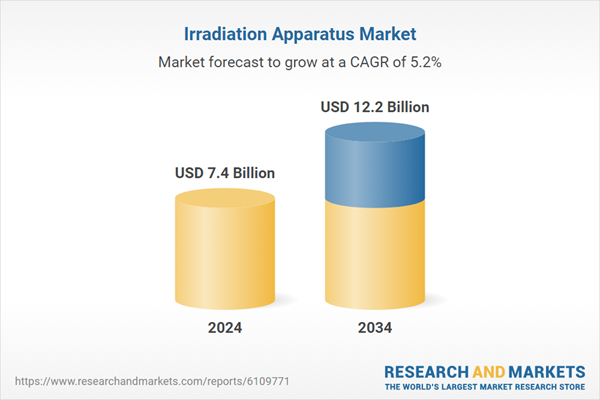The rising adoption of radiotherapy in cancer care is a significant factor propelling the market growth, as precision-targeted irradiation systems improve both outcomes and patient experiences. A strong push toward early detection and immediate intervention is increasing investments in devices such as brachytherapy equipment and linear accelerators. With oncology clinics and specialized medical centers expanding globally, the adoption of advanced irradiation systems continues to rise, underscoring the demand for efficient and accessible cancer treatment technologies.
Modern innovations in image-guided radiation therapy and AI-enabled systems are reshaping the landscape of irradiation apparatus. Integrated with robotic control and real-time imaging, these platforms provide accurate dose delivery to tumors while safeguarding surrounding tissues. Technologies such as linear accelerators and image-guided radiotherapy are now delivering higher levels of precision and lower complication risks, leading to widespread adoption across healthcare facilities.
Enhanced therapeutic outcomes, reduced recovery times, and minimized side effects are encouraging hospitals and clinics to transition to next-generation systems. In emerging regions, increased investments from both public and private sectors are supporting healthcare infrastructure upgrades, helping close treatment accessibility gaps. As demand grows for radiation-based solutions in both treatment and sterilization, the global market is being fueled by healthcare reforms and technology-driven improvements.
In 2024, the gamma irradiator segment accounted for the largest market share at 41.8%. The growing consumption of disposable medical products has been a major driver for gamma-based sterilization systems. As gamma radiation enables effective sterilization of heat-sensitive and chemically delicate items, manufacturers are increasingly relying on this method for syringes, catheters, and surgical gloves.
Sterilization processes using gamma rays leave no harmful residue, offering a reliable solution in regulated medical environments. These systems are also essential in treating blood components to prevent adverse post-transfusion reactions. With infection control and sterility assurance gaining focus across global regulatory bodies, gamma irradiators continue to be a preferred solution in the manufacture and processing of critical healthcare equipment and supplies.
The hospitals and clinics segment led the market in 2024 with a share of 53.9%. These facilities are primary users of irradiation apparatus, utilizing them extensively for diagnostic imaging and therapeutic interventions. Equipment like X-ray units, CT systems, and fluoroscopy machines play a pivotal role in evaluating patient conditions non-invasively.
Moreover, to combat healthcare-associated infections, hospitals are turning to irradiation-based sterilization for invasive medical tools, ensuring both patient safety and compliance with hygiene regulations. Compared to heat or chemical alternatives, irradiation offers a faster and more dependable method for sterilizing surgical instruments and other reusable components. The combination of diagnostic accuracy and infection prevention is making irradiation apparatus indispensable across modern healthcare facilities.
U.S. Irradiation Apparatus Market was valued at USD 3 billion in 2024 and is estimated to reach USD 4.9 billion by 2034. A growing prevalence of chronic illnesses - particularly cancer - is pushing demand for advanced radiation therapy solutions across the country. In tandem, the U.S. healthcare industry’s emphasis on decentralized treatment settings like ambulatory surgical centers and outpatient clinics is accelerating the need for compact, efficient sterilization systems.
As these smaller facilities look for high-throughput and space-saving solutions, modular irradiation systems have become highly attractive due to their speed, reliability, and ability to preserve equipment integrity. This shift toward cost-effective and distributed healthcare models is expected to sustain robust growth for irradiation technologies across both urban and rural settings.
Key industry participants shaping the competitive landscape of the Irradiation Apparatus Market include GE HealthCare, Elekta, Siemens Healthineers, Mindray, Canon Medical Systems, NPB Ion Beam Technology, Neusoft Medical Systems, Accuray, ViewRay, Hitachi, Sumitomo Heavy Industries, Shinva Medical, Koninklijke Philips, Mevion Medical Systems, and Panacea Medical Technologies. These companies continue to set benchmarks through product innovation and strategic expansion.
Leading players in the irradiation apparatus space are focusing on product portfolio expansion through advanced imaging-guided and AI-integrated radiation systems. Many companies are heavily investing in R&D to boost treatment accuracy, automate workflows, and enhance safety. Collaborations with cancer treatment centers and healthcare institutions are helping tailor solutions that match evolving clinical needs. To address global demand, especially in underserved regions, firms are developing modular and cost-effective systems that reduce installation complexity.
Comprehensive Market Analysis and Forecast
- Industry trends, key growth drivers, challenges, future opportunities, and regulatory landscape
- Competitive landscape with Porter’s Five Forces and PESTEL analysis
- Market size, segmentation, and regional forecasts
- In-depth company profiles, business strategies, financial insights, and SWOT analysis
This product will be delivered within 2-4 business days.
Table of Contents
Companies Mentioned
- Accuray
- Canon Medical Systems
- Elekta
- GE HealthCare
- Hitachi
- Koninklijke Philips
- Mevion Medical Systems
- Mindray
- Neusoft Medical Systems
- Panacea Medical Technologies
- Shinva Medical
- Siemens Healthineers
- Sumitomo Heavy Industries
- ViewRay
Table Information
| Report Attribute | Details |
|---|---|
| No. of Pages | 130 |
| Published | June 2025 |
| Forecast Period | 2024 - 2034 |
| Estimated Market Value ( USD | $ 7.4 Billion |
| Forecasted Market Value ( USD | $ 12.2 Billion |
| Compound Annual Growth Rate | 5.2% |
| Regions Covered | Global |
| No. of Companies Mentioned | 14 |









